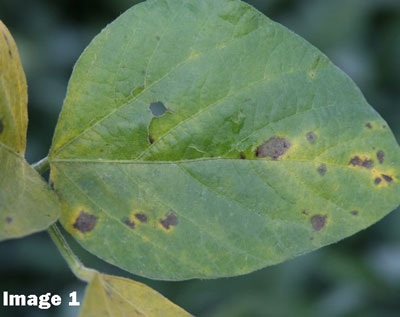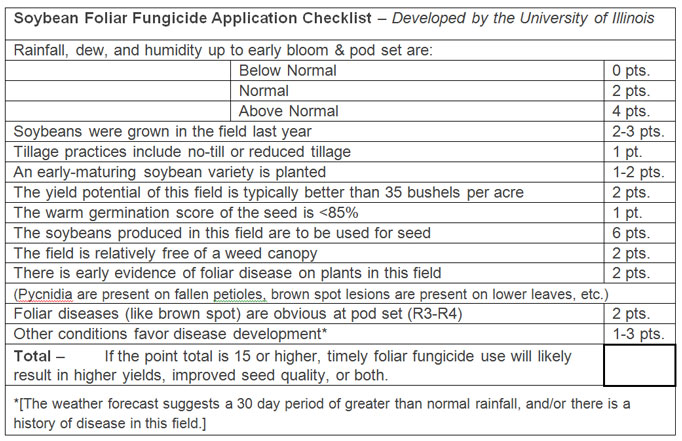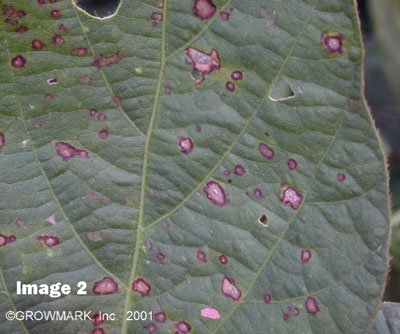
- Fungicide application to soybeans can be a good investment, even in years with low soybean prices.
- Use the checklist, included here, to select fields where fungicide application will pay.
- Tank mixing insecticides with fungicides should be considered with consideration for best timing and product efficacy.
- The best timing for fungicides on soybeans is R3 to R4. We explain why.
Making Fungicides Pay on Soybeans
The return on Investment (ROI) for fungicides on soybeans tends to not be as high or as consistent as for fungicide application to corn. However, this should not dissuade the soybean grower from making the decision to apply fungicides to soybeans. By using the following application checklist, it is possible to quickly determine which fields are likely candidates for productive use of soybean foliar fungicides.

In general, in the Midwest, we tend to see greatest response to foliar fungicides in soybeans as we move east and south. This is a function of the normal climate in these areas, especially for rainfall frequency and humidity. For example, Ohio tends to have much greater soybean foliar disease risk than does Iowa. This year, over a wide geographic area, frequent rainfall may easily bump the decision to being in favor of foliar fungicide application.
Tank Mixes
When insect pests, like Japanese beetles, attack soybeans it is logical to question whether it's practical to include insecticides in the spray tank with the fungicides. Timing of these applications seldom overlaps perfectly, so the first question is "What is most important?" Should the insecticide problem take precedence, or the need for timely fungicide application? If the needed timing for both these applications is close together, then tank mixing can be a sound decision, as long as respective product labels approve the tank mix.
Consider, also, the possibility of unintended consequences. There are both beneficial fungi and beneficial insects present in soybean fields. Application of either, or both, insecticides or fungicides can adversely affect these beneficial organisms, resulting in unexpected increase in other pests, like spider mites or soybean aphids. Again, this should not deter applications of fungicides or insecticides, but unnecessary applications of these products should be avoided. Diligent scouting should be the foundation for the product application decision.
Fungicide Application Timing
Experience and numerous field trials have shown that the best timing for fungicide application for foliar disease management is at the R3 to R4 growth stage (early and full pod set). Application needs to be at early bloom (R1) for white mold suppression and a second application may then be necessary by R3 to R4. Part of the reason for this timing is that vegetative growth of indeterminate soybeans slows by the R3 to R4 growth stages (though it doesn't stop altogether). Fungicides are primarily protective, and even systemic fungicides tend to translocate downward, not outward into new leaf tissue. Applying fungicides too early results in new foliage being unprotected against disease infection. Soybean white mold is different because infection occurs through dying blossoms. We need to protect the flowers in order to slow the disease.
Contact your FS Crop Specialist for your agronomic information.

Image 1: Cercospora Leaf Blight Lesions, a common foliar disease of soybeans
Image 2: Frogeye Leaf Spot, a disease becoming resistant to fungicides